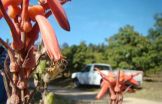(Press-News.org) Conventional wisdom in brain research says that you just used your hippocampus to answer that question, but that might not be the whole story. The context of place depends on not just how you got there, but also the things you see around you. A new study in Neuron provides evidence that a different part of the brain is important for understanding where you are based on the spatial layout of the objects in that place. The finding, in rats, has a direct analogy to primate neuroanatomy.
"Understanding how and where context is represented in the brain is important," said study senior author Rebecca Burwell, professor of psychology and neuroscience at Brown University. "Context, or the place in which events occur, is the hallmark of episodic memory, but context is more than a place or a location. This room, for example, has a window, furniture, and other objects. You walk into a room and all that information helps you remember what happened there."
Pinpointing where the brain puts together objects and places to form a context could also matter for treating traumatic brain injuries or neuropsychiatric diseases, such as schizophrenia and depression, that involve that part of the brain, said Burwell, who is also affiliated with the Brown Institute for Brain Science.
"We know that contextual representations are disrupted in mental disorders, particularly schizophrenia and depression," Burwell said. "Individuals with these disorders have trouble using context to plan actions or choose appropriate behaviors."
Part of the funding for the study came from a defense department grant aimed at laying the basic neuroscience framework for ultimately repairing traumatic brain damage.
Ratting out dogma
The particular region of Burwell's interest is called the postrhinal cortex, or POR, in rats. It is directly analogous to the parahippocampal cortex, or PHC, in primates including humans. Neuroscientists already credit the POR, and the PHC, with a significant role in encoding spatial context, mainly by providing spatial information to the hippocampus ("There is a wall five feet to the left"), but they have presumed that another brain region, the perirhinal cortex (PER), provides the hippocampus with information about objects ("I see a fish sculpture").
"The dogma is that this spatial and nonspatial information is segregated," Burwell said. That is, until those two streams of information are finally integrated by the hippocampus ("The fish sculpture is on the left-hand wall shelf.").
But previous research has shown that the PER and POR talk directly to each other. Also, damage to either of those brain regions results in rats that become confused about context. For those, and other reasons, Burwell's team hypothesized that the POR links objects to places to encode spatial context upstream of the hippocampus.
"That's what we think is happening in the POR," she said. "It's integrating information about place and information about objects to characterize the spatial layout of a local context."
That object in that place
To find out, the authors surgically inserted electrodes near dozens of POR neurons in each of five rats. The rats were trained to perform a series of experimental tasks in a simple bowtie-shaped "maze." Each time, they had to choose between a pair of images (objects) projected into two corners (places) of the maze floor. When the rats moved to the "correct" object, they were rewarded with sips of 2% fat chocolate milk.
The researchers found that neurons in the POR responded in patterns of electrical activity, or "spiking," not only when the rats looked at objects or scurried to places, but also when specific objects (like one associated with a reward) turned up in specific places. That is, neurons often spiked when a particular object appeared in a particular corner.
The rats even exhibited a specific neural response for "egocentric" movements. In other words, the rats' POR neurons didn't just account for object location in an objective "this side of the maze or that side" sense, but also for a self-specific "on my left or on my right" basis, indicating that the POR considers space relative to the self, regardless of where a particular object might be in the room.
Networks of POR neurons also tended to fire rhythmically at a specific frequency, called "theta," that neuroscientists think coordinates long-distance communication across the brain.
"It was a surprise to see this whopping theta in the POR," Burwell said.
Theta rhythm was particularly strong when rats chose an unrewarded object. Burwell said that indicates the POR may be responsible for telling other parts of the brain when the wrong choice of object and place has been made.
"The POR," Burwell said, "is not just a relay station for spatial information."
It appears to be much more.
INFORMATION:
In addition to Burwell, the paper's authors are former lab member, Sharon Furtak, now at California State University-Sacramento, and collaborator, Omar Ahmed, formerly at Brown and now at Massachusetts General Hospital.
The Defense Advanced Research Projects Agency (grant N66001-10_C-2010), the National Science Foundation (grant IOB-0522220) and the National Institutes of Health (grants T32-MH019118 and F32-MH084443) supported the research.
Where 'where it's at' is at in the brain
Study in rats identifies region that associates objects and space
2012-12-05
ELSE PRESS RELEASES FROM THIS DATE:
Study shows antibody therapy clears Alzheimer's plaques in mice
2012-12-05
Antibodies against amyloid beta (Aβ) protein deposits that are thought to play a role in Alzheimer's disease have shown some success in preventing the buildup of deposits in animals, but they have not been effective at removing preexisting deposits. Now researchers reporting in the December issue of the Cell Press journal Neuron show that a modified antibody was able to clear preexisting Aβ deposits in a mouse model of Alzheimer's disease.
"These findings have important implications for current and future development of antibodies for the treatment of Alzheimer's ...
Galaxy-wide echoes from the past
2012-12-05
Many galaxies have a giant black hole at their centre that causes the gas around it to glow. However, in the case of green bean galaxies, the entire galaxy is glowing, not just the centre. These new observations reveal the largest and brightest glowing regions ever found, thought to be powered by central black holes that were formerly very active but are now switching off.
Astronomer Mischa Schirmer of the Gemini Observatory had looked at many images of the distant Universe, searching for clusters of galaxies, but when he came across one object in an image from the Canada-France-Hawaii ...
Mayo Clinic: Less invasive surgery detects residual breast cancer in lymph nodes after chemotherapy
2012-12-05
ROCHESTER, Minn. — Most patients whose breast cancer has spread to their lymph nodes have most of the lymph nodes in their armpit area removed after chemotherapy to see if any cancer remains. A study conducted through the American College of Surgeons Oncology Group and led by Judy Boughey, M.D. a breast surgeon at Mayo Clinic shows that a less invasive procedure known as sentinel lymph node surgery successfully identified whether cancer remained in lymph nodes in 91 percent of patients with node-positive breast cancer who received chemotherapy before their surgery. In sentinel ...
Scientists pinpoint great-earthquake hot spots
2012-12-05
"We find that 87% of the 15 largest (8.6 magnitude or higher) and half of the 50 largest (8.4 magnitude or higher) earthquakes of the past century are associated with intersection regions between oceanic fracture zones and subduction zones," says Dietmar Müller, researcher at the University of Sydney in Australia and lead author of the Solid Earth paper. The connection is less striking for smaller earthquakes.
Powerful earthquakes related to these intersection regions include the destructive 2011 Tohoku-Oki and 2004 Sumatra events.
"If the association we found were ...
URI oceanography student uses crashing waves on shorelines to study Earth's interior
2012-12-05
NARRAGANSETT, R.I. – December 5, 2012 – Scientists have long used the speed of seismic waves traveling through the Earth as a means of learning about the geologic structure beneath the Earth's surface, but the seismic waves they use have typically been generated by earthquakes or man-made explosions. A University of Rhode Island graduate student is using the tiny seismic waves created by ocean waves crashing on shorelines around the world to learn how an underwater plateau was formed 122 million years ago.
"There are any number of ways to create seismic waves, but most ...
Wind speeds in southern New England declining inland, remaining steady on coast
2012-12-05
NARRAGANSETT, R.I. – December 5, 2012 – Oceanographers at the University of Rhode Island have analyzed long-term data from several anemometers in southern New England and found that average wind speeds have declined by about 15 percent at inland sites while speeds have remained steady at an offshore site.
Kelly Knorr, a graduate student at the URI Graduate School of Oceanography, and Professor John Merrill reported the results of their research today at the fall meeting of the American Geophysical Union in San Francisco.
The researchers found that average wind speeds ...
Gladstone scientists: 'ApoE is an ideal target for halting progression of Alzheimer's disease'
2012-12-05
SAN FRANCISCO, CA—December 5, 2012—Despite researchers' best efforts, no drug exists that can slow, halt or reverse the onslaught of Alzheimer's disease. A progressive and fatal neurodegenerative disorder, Alzheimer's has stolen the memories and livelihoods of millions—leaving patients and their families struggling to cope with the disease's devastating consequences. But today, scientists at the Gladstone Institutes propose a new research avenue that has the potential to change all that.
In the latest issue of the journal Neuron, available today online, Gladstone Investigators ...
Africa's Homo sapiens were the first techies
2012-12-05
The search for the origin of modern human behaviour and technological advancement among our ancestors in southern Africa some 70 000 years ago, has taken a step closer to firmly establishing Africa, and especially South Africa, as the primary centre for the early development of human behaviour.
A new research paper by renowned Wits University archaeologist, Prof. Christopher Henshilwood, is the first detailed summary of the time periods he and a group of international researchers have been studying in South Africa: namely the Still Bay techno-traditions (c. 75 000 – 70 ...
Discovery of 100 million-year-old regions of DNA shows short cut to crop science advances
2012-12-05
Scientists have discovered 100 million-year-old regions in the DNA of several plant species which could hold secrets about how specific genes are turned 'on' or 'off'.
The findings, which are hoped will accelerate the pace of research into crop science and food security, are detailed by University of Warwick researchers in the journal The Plant Cell.
By running a computational analysis of the genomes of the papaya, poplar, Arabidopsis and grape species, scientists have uncovered hundreds of conserved non-coding sequences which are found in the DNA of all four species.
These ...
Small patches of native plants help boost pollination services in large farms
2012-12-05
A combined team of scientists from Europe and South Africa (Luísa G. Carvalheiro (University of Leeds, UK & Naturalis Biodiversity Research Centre, Netherlands), Colleen Seymour and Ruan Veldtman (SANBI, South Africa) and Sue Nicolson (University of Pretoria)) have discovered that pollinator services of large agriculture fields can be enhanced with a simple cost-effective measure, that involves the creation of small patches of native plants within fruit orchards.
"Mango farmers in South Africa are aware of the pollination limitation of this crop and invest a substantial ...
LAST 30 PRESS RELEASES:
New mega-analysis reveals why memory declines with age
Understanding ammonia energy’s tradeoffs around the world
UTHealth Houston researchers map gene disruptions in sporadic early onset Alzheimer’s disease across key brain regions
Minimum wage increases are linked to safer pregnancies
Left in the cold: Study finds most renters shut out of energy-saving upgrades
This crystal sings back: Illinois collaboration sheds light on magnetochiral instability
Organisms in the Atacama Desert soil are remarkably diverse
Children’s Hospital Colorado research outlines first pediatric classifications for suicide risk in adolescents and kids
No thyme wasted: Harnessing the medicinal benefits of thyme extract With small doses
Fat surrounding the colon interacts with the immune system
Genetic predisposition to excess body weight and survival in women diagnosed with breast cancer
New mechanism links Epstein-Barr virus to MS
Genetic risk factor and viral infection jointly contribute to MS
When a virus releases the immune brake: New evidence on the onset of multiple sclerosis
Wyss Institute-led collaboration awarded by ARPA-H PRINT program to engineer off-the-shelf, universal, transplant-ready graft for liver failure
Research on the behavioral mechanisms of rural distributed photovoltaic development: A view of prosumer perspective
More surgical patients are on opioid use disorder medications — hospitals must modernize pain care
New study reveals strategic logic behind global patent litigation venue selection
An abnormally slow heart rate is associated with xylazine-fentanyl overdose; primarily seen in northeastern United States
The path to solar weather forecasts
Inflammation and mitochondrial dysfunction in cirrhotic cardiomyopathy: therapeutic implications
The Great Bear Rainforest nature writing retreat
Research reveals hidden diversity of E. coli driving diabetic foot infections
Breakthrough in parallel Cartesian grid generation: Dynamic partition weight strategy resolves load imbalance
ESMT Berlin study shows how startups can communicate to win over silent audiences online
Design and optimization of wide-speed double swept waverider based on curved-cone projection method
Giant Magellan Telescope names Daniel T. Jaffe as president
New parameterization method for cislunar space cataloging enhances orbital awareness in Earth-Moon system
A “nu” way to measure researcher impact
Dark matter may have begun much hotter than scientists thought
[Press-News.org] Where 'where it's at' is at in the brainStudy in rats identifies region that associates objects and space




